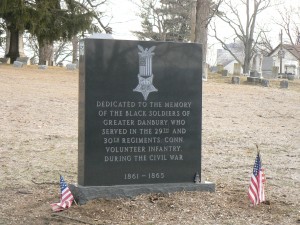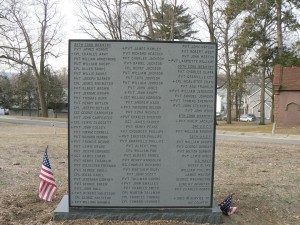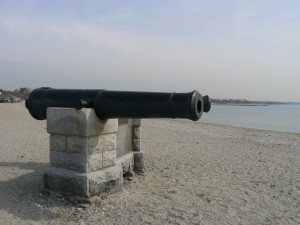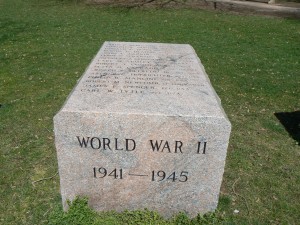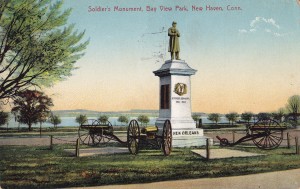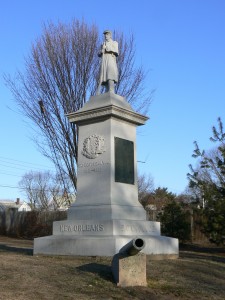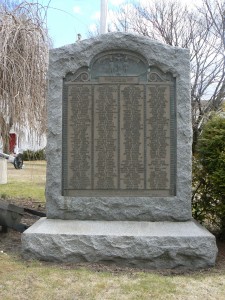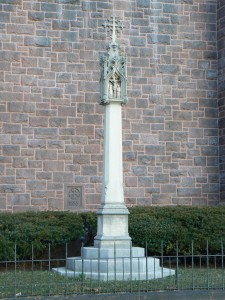 A boulder on Middletown Avenue in the Northford section of North Branford honors local residents who served in the wars between the American Revolution and World War II.
A boulder on Middletown Avenue in the Northford section of North Branford honors local residents who served in the wars between the American Revolution and World War II.
The boulder was first dedicated in 1920, when the bronze plaque on the front (east) face honored veterans of the American Revolution, Civil War and the World War. The monument’s dedication reads “Erected in 1920 by the Society of Northford in honor of her sons who answered their country’s call.”
The American Revolution section lists 50 names. The Civil War section lists 32 names, and the World War Honor Roll lists nine names.
The boulder sits in a small triangular area where Middletown Avenue intersects with Clintonville and Old Post roads. The church uphill from the monument is the Northford Congregational Church.
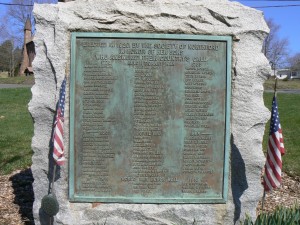 The rear side of the monument bears an undated plaque (obviously added after the war) that honors World War II veterans. The plaque lists the names of 78 local residents who served in the war, with stars indicating the names of two residents who were killed in the conflict.
The rear side of the monument bears an undated plaque (obviously added after the war) that honors World War II veterans. The plaque lists the names of 78 local residents who served in the war, with stars indicating the names of two residents who were killed in the conflict.
Source:
Connecticut Historical Society: Civil War Monuments of Connecticut
Tags: Northford
 An 1894 monument to soldiers and sailors in unknown graves has been joined by a 2007 monument to African-American soldiers in Danbury’s Wooster Cemetery.
An 1894 monument to soldiers and sailors in unknown graves has been joined by a 2007 monument to African-American soldiers in Danbury’s Wooster Cemetery.
The Monument to Soldiers in Unknown Graves was dedicated in 1894 to honor Connecticut Civil War Veterans who were reported missing after battles. The monument is topped by a granite soldier that, unique among Connecticut Civil War monuments, is holding a rifle at funeral rest position. Also uncommon is the cross at the soldier’s left, on the monument’s south face. (The Connecticut Soldiers’ Monument in St. Bernard’s Cemetery in New Haven also bears a cross on its front face).
The front and back of the monument are inscribed with the names and unit affiliations of local veterans who were lost in the Civil War.
 A bronze plaque has been affixed to the east face of the monument honoring Nathan E. Hickok, who was awarded a Congressional Medal of Honor for capturing a battle flag in 1864 during fighting near Richmond.
A bronze plaque has been affixed to the east face of the monument honoring Nathan E. Hickok, who was awarded a Congressional Medal of Honor for capturing a battle flag in 1864 during fighting near Richmond.
Next to the Monument to Soldiers in Unknown Graves is a black granite monument that was dedicated in 2007 to honor African-American veterans who volunteered for Civil War service. The front face of the monument bear the dedication “to the memory of the black soldiers of Greater Danbury who served in the 29th and 30th Regiments Conn. Volunteer Infantry during the Civil War 1981-1865.” The front face also bears an inscribed Grand Army of the Republic medal.
The rear of the monument bears 70 names from the 29th Conn., and honors 16 who were killed in service, as well as nine names from the 30th Conn., including three who were killed. The monument also lists a dozen names from other Connecticut and New York regiments and the U.S. Navy, including one soldier who lost his life.
Both monuments are not far from the David Wooster monument highlighted in last Friday’s post.
 A monument to the men of the 29th Regiment Conn. Volunteer Infantry was dedicated in 2008 in New Haven’s Criscuolo Park, and will be highlighted in a future post.
A monument to the men of the 29th Regiment Conn. Volunteer Infantry was dedicated in 2008 in New Haven’s Criscuolo Park, and will be highlighted in a future post.
Source:
Connecticut Historical Society: Civil War Monuments of Connecticut
Tags: Danbury
 A boulder on Main Street in Danbury commemorates the burning of several local buildings by British forces who invaded the city on April 26, 1777.
A boulder on Main Street in Danbury commemorates the burning of several local buildings by British forces who invaded the city on April 26, 1777.
After landing in Westport the day before, about 2,000 British troops entered Danbury with plans to attack war supplies being stored in the city. The troops destroyed food, medicine and ammunition, including a large grain-packed barn on Main Street that was burned.
The troops were also ordered to destroy a supply of local rum, but chose instead to drink it.
British General William Tryon (who would invade New Haven two years later) received a warning that Continental militia forces were in Bethel and planned to attack the troops. Tryon gathered his forces and began to evacuate Danbury. As they were leaving the city, the troops began burning houses of Continental supporters. All told, they burned 19 homes, and 22 storehouses and barns, in the city.
 The Connecticut militia sent forces from New Haven and Fairfield, who united under the command of Gen. David Wooster. After discussions in Bethel, about 400 troops commanded by Benedict Arnold (who hadn’t yet turned traitor) and Selleck Silliman set up a roadblock in Ridgefield and Wooster circled around to attack the British from the rear.
The Connecticut militia sent forces from New Haven and Fairfield, who united under the command of Gen. David Wooster. After discussions in Bethel, about 400 troops commanded by Benedict Arnold (who hadn’t yet turned traitor) and Selleck Silliman set up a roadblock in Ridgefield and Wooster circled around to attack the British from the rear.
During fighting near Ridgefield, Wooster was killed by a musket ball that struck his back. Arnold’s troops provided fierce resistance before being repelled by the British forces. The militia then launched a series of small skirmish attacks as the troops retreated to Westport and the safety of their ships, which they reached on April 28.
In Danbury, the invasion is marked by a boulder that sits in a small park on Main Street. The monument, not far from the city’s 9/11 memorial, has a bronze plaque that summarizes the battle. In part, the plaque reads “The Revolutionary Village which centered about this green with its store of supplies for the army was sacked and burned by a force of two thousand British, April 26, 1777.”
 Wooster, a native of Stratford (where a middle school is named after him), is buried in Wooster Cemetery, which is not far from the invasion monument. His grave is marked by a tall reddish obelisk that was erected by the Masons in 1854. The front (south) face bears a bas relief image of Wooster’s death. The east face has an image with symbolism that escapes us. The north and west faces have biographical information about Wooster’s life and contributions to the young United States as well as to the Masons.
Wooster, a native of Stratford (where a middle school is named after him), is buried in Wooster Cemetery, which is not far from the invasion monument. His grave is marked by a tall reddish obelisk that was erected by the Masons in 1854. The front (south) face bears a bas relief image of Wooster’s death. The east face has an image with symbolism that escapes us. The north and west faces have biographical information about Wooster’s life and contributions to the young United States as well as to the Masons.
Source:
Connecticut by Albert E. Van Dusen (Random House, 1961)
Tags: Danbury
 Several monuments on and near Westport’s Compo Beach mark the starting and ending point of the invasion of Danbury by British forces who landed there on April 25, 1777.
Several monuments on and near Westport’s Compo Beach mark the starting and ending point of the invasion of Danbury by British forces who landed there on April 25, 1777.
The British brought about 2,000 troops to Westport, who planned to destroy war supplies being stored about 20 miles north in Danbury. The British spent the night in Weston before reaching Danbury on April 26, where they destroyed food, medicine and ammunition (but didn’t do a great job of destroying a cache of rum, which they drank instead).
Warned of the pending arrival of local militia, the British evacuated Danbury and retreated south, engaging in battles in Ridgefield and Westport before sailing away on April 28. The British suffered more than 200 casualties in the fighting, and the Americans had 20 men killed and 40 wounded.
Westport marks the battles with three monuments. At the intersection of Compo Road South and Post Road East, a boulder bears a plaque reading “Here occured the first engagement between the Continentals and the British Troops when they invaded Connecticut April-25-1777.” The plaque was dedicated in 1914 by the Connecticut Society Sons of the American Revolution.
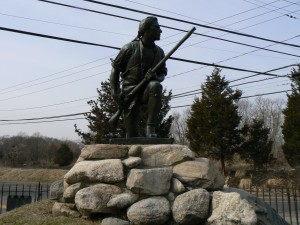 The site, on a small traffic median, is also marked by a brown hanging sign bearing the Connecticut logo and the inscription “One mile south at Compo Beach, 2000 British Troops landed April 25, 1777, for raid on Danbury.”
The site, on a small traffic median, is also marked by a brown hanging sign bearing the Connecticut logo and the inscription “One mile south at Compo Beach, 2000 British Troops landed April 25, 1777, for raid on Danbury.”
A bit further down Compo Road, Westport’s Minuteman monument kneels atop a traffic circle at the intersection of Compo Road South and Compo Beach Road. The monument depicts a musket-wielding Continental soldier waiting with his sleeves rolled up for the returning Redcoats.
A plaque on the north side of the base reads “To commemorate the heroism of the patriots who defended their country when the British invaded this state April 25th 1777. General David Wooster, Colonel Abraham Gould and more than one hundred Continentals fell in the engagements commencing at Danbury and closing on Compo Hill”
 The monument, created by sculptor Harry Daniel Webster, was cast by Tiffany Studios in 1910.
The monument, created by sculptor Harry Daniel Webster, was cast by Tiffany Studios in 1910.
Continuing south to Compo Beach, a pair of large cannons have been mounted on a granite base to commemorate the fighting on and near the beach as the British returned to their ships. The cannons, whose markings can’t be distinguished, were donated by the U.S. government. The monument, dedicated in 1901, was restored in 1999.
(On Friday, we’ll look at Danbury’s monument to the invasion and the nearby grave of Gen. David Wooster.)
Tags: Westport
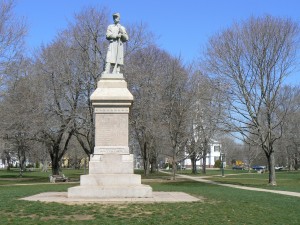 A two-toned monument of pink and gray granite honoring Civil War veterans stands at the center of the green in Guilford.
A two-toned monument of pink and gray granite honoring Civil War veterans stands at the center of the green in Guilford.
The monument, featuring an infantryman standing with a rifle in his hands, was completed in two stages that were dedicated 10 years apart. The base, made of pink granite quarried locally, was dedicated in 1877. The soldier, made of gray granite and supplied from a Massachusetts firm, was dedicated in 1887.
Such a delay in the construction of Civil War monuments, while not common, was not unique to Guilford. The figure atop the Soldiers’ Monument on the Derby Green, for instance, was dedicated six years after the base.
 The dedication on the front (south) face of the Guilford monument reads: “In memory of the men of Guilford who fell and in honor of those who served in the war for the Union, the grateful town erects this monument, that their example may speak to coming generations.” The south face also lists the battle of Antietam, as well as the names and regimental affiliations of 14 residents killed in the war.
The dedication on the front (south) face of the Guilford monument reads: “In memory of the men of Guilford who fell and in honor of those who served in the war for the Union, the grateful town erects this monument, that their example may speak to coming generations.” The south face also lists the battle of Antietam, as well as the names and regimental affiliations of 14 residents killed in the war.
The east face lists Gettysburg and an additional 14 names. The north face, which is harder to read, lists Fredericksburg (Va.) and an estimated 15 names. The west face lists Port Royal (S.C.) and 14 names. The first name listed on the west face is Douglas Fowler, a Guilford native who was commanding the 17th Conn. Volunteer Regiment when he was killed in Gettysburg on the first day of the battle (July 1, 1863).
The gray infantry figure, like many Hollywood starlets, appears to have undergone repairs to his nose at some point during the 121 years he has stood in Guilford.
On the southwest corner of the green, a boulder bears a bronze plaque dedicated “in honor of our men and women who served in the World War 1917 1918.” The monument also lists the names of about 97 residents who served, as well as four names of residents who gave their lives in the conflict.
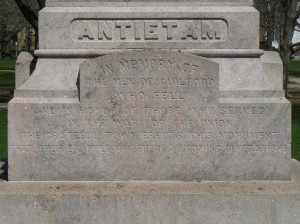 The town’s World War II monument, on the southeast corner of the green, features three blocks of pink granite (that also may have been quarried locally). The central block, the largest of the three, honors 16 residents who died in the war by listing their names, ranks and service affiliations. The blocks to the east and west bear bronze plaques describing Guilford’s contributions to the war, including the fact that 500 men and women served in the military as well as the efforts of local farms and businesses.
The town’s World War II monument, on the southeast corner of the green, features three blocks of pink granite (that also may have been quarried locally). The central block, the largest of the three, honors 16 residents who died in the war by listing their names, ranks and service affiliations. The blocks to the east and west bear bronze plaques describing Guilford’s contributions to the war, including the fact that 500 men and women served in the military as well as the efforts of local farms and businesses.
The Vietnam war sacrifice of three residents is honored by a 1984 monument on the northwest corner of the green. That granite monument bears the dedication “Each peaceful dawn in this place we are reminded of these men who died for their country.”
 A tree near the Vietnam monument has been dedicated to the memory of 9/11 victims, and a monument near the northeast corner of the green honors local firefighters.
A tree near the Vietnam monument has been dedicated to the memory of 9/11 victims, and a monument near the northeast corner of the green honors local firefighters.
Source:
Connecticut Historical Society: Civil War Monuments of Connecticut
Tags: Guilford
 A 1903 granite monument dedicated to a Civil War regiment comprised primarily of Irish Americans stands in New Haven’s Bay View Park.
A 1903 granite monument dedicated to a Civil War regiment comprised primarily of Irish Americans stands in New Haven’s Bay View Park.
The 9th Regiment Connecticut Volunteers monument is located in a park that served as the unit’s training ground and home for a few months following its formation in 1861. A caped infantryman stands with a rifle atop a short granite pillar.
The front (south) face of the monument bears the Connecticut state seal above the name of the regiment and “1861-1865”. The base of the monument also lists the battle of New Orleans.
A bronze plaque on the east face lists nearly 100 names of unit members who died in service as well as the battle of Baton Rouge. The north face lists nearly 80 names and the battle of Cedar Creek (Va.), and the west face lists nearly 85 names as well as Fishers Hill (Va.)
 The vintage postcard below shows the monument has undergone several changes since its 1903 dedication. Originally, the monument’s decorative elements were painted gold. Looking closely at the monument, some traces of the gold paint remain. For instance, look at the period (click to enlarge the images) in “Regt.” and the dash between 1861 and 1865.
The vintage postcard below shows the monument has undergone several changes since its 1903 dedication. Originally, the monument’s decorative elements were painted gold. Looking closely at the monument, some traces of the gold paint remain. For instance, look at the period (click to enlarge the images) in “Regt.” and the dash between 1861 and 1865.
In addition, the monument was moved from its 1903 location in 1950. Route 1, which runs near the park, was re-routed to accommodate the construction of Interstate 95. This construction in turn prompted changes to the park and the monument, which originally stood at the east end of the park, closer to the harbor (probably on the site of the aquaculture school).
Finally, the four cannons were removed from their carriages and re-mounted on concrete bases. The cannons are original Civil War 12-pounder Dahlgren guns, which were naval cannons known as “boat howitzers” that could be mounted on carriages and brought ashore for land use.
A new monument honoring the 9th Regiment was dedicated in October 2008 at the Vicksburg National Military Park. More information about the regiment’s history and the new monument is available here.
Source:
Connecticut Historical Society: Civil War Monuments of Connecticut
Tags: New Haven
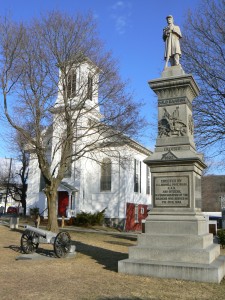 Thomaston’s Civil War monument, dedicated in 1902, stands in a small park surrounded by monuments to the two World Wars and the conflicts that followed.
Thomaston’s Civil War monument, dedicated in 1902, stands in a small park surrounded by monuments to the two World Wars and the conflicts that followed.
The Soldiers’ Monument is a multi-layered, square granite shaft topped by a caped infantryman holding a rifle by its barrel. The front (west) side of the shaft bears the dedication “Erected by C.L. Russell Post, No. 68, G.A.R. and citizens, in commemoration of the soldiers who served in the Civil War.” (The G.A.R. refers to the Grand Army of the Republic, the post-Civil War veterans organization.)
The west face also bears an ornate symbolic eagle in front of two crossed flags, and the battle of Cold Harbor (Va.) is displayed just below the infantryman’s feet.
The south face commemorates the battle of Gettysburg and features an ornate wreath. The east face honors the battle of Cedar Creek (Va.) and displays the seal of the state of Connecticut. The north face bears a GAR medal and commemorates the battle of Appomattox (Va.), the site of General Lee’s surrender.
An 1863 cannon stands to the north of the monument, and a later-vintage cannon (perhaps from World War I) stands on the south side of the monument.
 Behind the Civil War monument, a large granite memorial honors veterans from World War II, Korea, Vietnam and in the Persian Gulf. Several bronze plaques list local residents who served in these conflicts, with the World War II monument listing an estimated more than 1,200 names among its five columns. The Korean conflict plaques list more than 165 names, and the Vietnam plaques list an estimated 225 or so names.
Behind the Civil War monument, a large granite memorial honors veterans from World War II, Korea, Vietnam and in the Persian Gulf. Several bronze plaques list local residents who served in these conflicts, with the World War II monument listing an estimated more than 1,200 names among its five columns. The Korean conflict plaques list more than 165 names, and the Vietnam plaques list an estimated 225 or so names.
The southwest corner of the park features the World War I Roll of Honor, which was dedicated “by the town of Thomaston to those who served their country in the World War.”
The Roll of Honor monument, which has an iron fence in front of it, also bears a quote from President Woodrow Wilson reading “in a righteous cause they have won immortal glory and have nobly served their nation in serving mankind.”
The monument also features a stylized representation of Liberty standing between a soldier and a sailor, who are surrounded with symbolic flourishes including an airplane, a lighthouse, a cannon and other decorative elements.
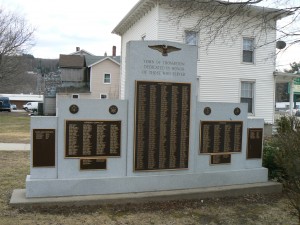 Below these elements is a bronze plaque with four columns of names honoring members of the Army, Navy, Marines and, in an uncommon but rather nice touch, 10 Red Cross and Army nurses.
Below these elements is a bronze plaque with four columns of names honoring members of the Army, Navy, Marines and, in an uncommon but rather nice touch, 10 Red Cross and Army nurses.
Source:
Connecticut Historical Society: Civil War Monuments of Connecticut
Tags: Thomaston
 A 32-foot column in a park at the intersections of Elm Street and Broadway in New Haven honors the service of four Connecticut regiments in the Civil War.
A 32-foot column in a park at the intersections of Elm Street and Broadway in New Haven honors the service of four Connecticut regiments in the Civil War.
The column, topped by a bronze eagle and flanked by two granite soldiers, was dedicated on June 16, 1905, to honor three infantry regiments and an artillery regiment.
A dedication on the front (south) face on the monument reads: “Erected by the joint contributions of the state of Connecticut and the Veteran Associations of 1st Conn. Light Battery and 6th, 7th and 10th Conn. Vols. as a sacred and perpetual memorial to men who suffered and died that the republic might live: 1861-1865.”
Beneath this dedication, a bronze plaque honors the 10th Conn. Volunteer Infantry, which participated in 51 engagements between Sept. 1861 and Sept. 1865. Among the 1,879 soldiers who enrolled in the regiment, there were 1,011 casualties. The bottom of the plaque bears the inscription “Safe and happy the republic whose sons gladly die in her defense.”
On the east side of the monument, a figure depicts an infantry soldier reaching into an ammunition bag. On the base beneath his feet, a bronze plaque honors the Seventh Connecticut Volunteers infantry regiment, who participated in battles in South and North Carolina and Georgia, as well as “13 other engagements.”
 The west side of the monument features a figure depicting an artilleryman scanning the horizon while holding a ramrod in his left hand. A plaque beneath this figure honors the 1st Conn. Light Battery, which served between Oct. 1861 and June 1865. Major engagements cited on the plaque include the siege of Charleston, and the Richmond and Petersburg campaigns in Virginia.
The west side of the monument features a figure depicting an artilleryman scanning the horizon while holding a ramrod in his left hand. A plaque beneath this figure honors the 1st Conn. Light Battery, which served between Oct. 1861 and June 1865. Major engagements cited on the plaque include the siege of Charleston, and the Richmond and Petersburg campaigns in Virginia.
A plaque on the south side of the monument commemorates the 6th Conn. Volunteer Infantry, which served between Sept. 1861 and August 1865. The regiment had a total enrollment of 1,608 and suffered 807 casualties during engagements in Virginia, South Carolina and Georgia.
The vintage postcard below carries a 1909 postmark, and was mailed to Jamaica, New York. The fountain and the reddish street furniture in the foreground have been removed from the park.
 A booklet commemorating the monument’s dedication ceremonies is available on the Internet Archive.
A booklet commemorating the monument’s dedication ceremonies is available on the Internet Archive.
The pile of stones in the northwest corner of the park marks the number of military and civilian deaths in the wars in Iraq and Afghanistan. Every month, the number of deaths is painted on a stone that is added to the pile.
Just north of the Civil War monument is Christ Church, which was built in 1895. A monument outside the south side of the church is dedicated to George Brinley Morgan, who became pastor of the church in 1878. Rev. Morgan was killed in a motor car accident in 1908, which was likely not yet a common cause of death in that era.
Source:
Connecticut Historical Society: Civil War Monuments of Connecticut
Tags: New Haven
 The city of Danbury has honored the state’s victims of the Sept. 11 terrorist attacks with an 12-foot glass sculpture that rises from a five-sided granite base.
The city of Danbury has honored the state’s victims of the Sept. 11 terrorist attacks with an 12-foot glass sculpture that rises from a five-sided granite base.
A plaque near the monument bears the dedication “in loving memory to Connecticut victims of the terrorist attack on the United States September 11, 2001.”
The memorial, dedicated in 2004, stands on Main Street near the former Fairfield County Courthouse. The monument was crafted from shards of broken glass that were fused into a hollow rectangle in the shape of a former World Trade Center tower.
Within the tower, a long sheet of glass is etched with the names of the 152 victims of 9/11 from Connecticut.
 The monument, which is lighted at night, rises from a Pentagon-shaped base of granite blocks that sits at the center of a small plaza with two benches and a pathway lined with flags.
The monument, which is lighted at night, rises from a Pentagon-shaped base of granite blocks that sits at the center of a small plaza with two benches and a pathway lined with flags.
The monument was created by sculptor Henry Richardson, who has other glass works on display in Maine, Connecticut and Florida.
Additional information:
Tags: Danbury
 A large rectangular monument on Main Street in Ridgefield honors local residents who served in wars between the American Revolution and World War I.
A large rectangular monument on Main Street in Ridgefield honors local residents who served in wars between the American Revolution and World War I.
The monument, on Main Street in front of the Methodist Church, was dedicated in 1925. The front (east) face of the monument bears the dedication “To the memory of the citizens of Ridgefield who served their country in the wars of the republic 1775-1918. Erected by the people of Ridgefield MCMXXIV (1924)”
The east plaque, along with the dedication, bears ornate decorative details that include cannons, flags, medals, a propeller, a scale and a variety of other symbols and interlocking lines.
 The west (rear) side of the monument (facing Main Street from the church grounds) honors veterans of the War of the Revolution (nearly 250 names), War of 1812 (five names) and Mexican War (two names).
The west (rear) side of the monument (facing Main Street from the church grounds) honors veterans of the War of the Revolution (nearly 250 names), War of 1812 (five names) and Mexican War (two names).
The south side bears a plaque listing two names of Spanish-American War veterans as well as nearly 150 names of World War veterans. (The shrubbery on this side of the monument is nearly touching the plaque, and could use some trimming.)
The north side plaque honors 185 Civil War veterans.
Tags: Ridgefield



